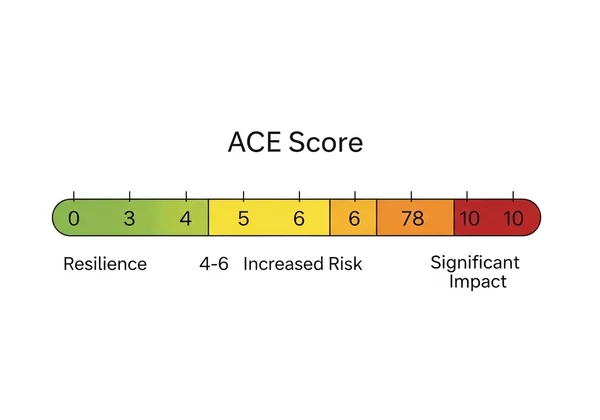ACE測驗:理解您的分數、意義與解讀
您最近是否進行了ACE(童年逆境經驗)測驗並獲得了分數?或者您只是在學習ACEs,並想知道 分數真正代表什麼?了解您的 ACE分數的含義 是獲得對您健康和福祉的深刻見解的關鍵一步。本指南將幫助您理解您的ACE分數的含義,為這個重要的童年逆境指標提供清晰度和背景。了解您的分數如何被解讀以及為何理解它是自我認知和療癒的第一步。為了開始您自己的旅程,您可以 立即開始您的ACE測驗之旅。
您的ACE分數意味著什麼?
要真正深入理解 ACE分數的含義,了解其起源和測量內容至關重要。您的ACE分數是一個簡單的計數,從0到10,代表您在18歲之前經歷的各種逆境。每一次逆境經驗計為一分,無論其嚴重程度或頻率如何。這種標準化的方法為理解童年逆境的潛在影響提供了一個共同的框架。

ACE研究:基礎概覽
逆境童年經驗(Adverse Childhood Experiences,簡稱ACEs)的概念源於疾病管制與預防中心(CDC)和Kaiser Permanente在1990年代中期進行的一項開創性研究。這項具里程碑意義的 ACE研究 涵蓋了超過17,000名成年人,揭示了童年創傷與成年後各種負面健康結果之間驚人的關聯性,範圍涵蓋慢性疾病、心理健康問題及社會挑戰等層面。研究人員確定了10個特定的 逆境童年經驗 類別,包括虐待(身體、情感、性)、疏忽(身體、情感)以及家庭功能障礙(父母濫用藥物、精神疾病、離婚、有服刑親屬、家庭暴力)。這項廣泛的研究為理解早期經驗能如何顯著影響我們的長期健康提供了科學基礎。
ACE分數量表:從零到十
ACE分數量表 非常簡單明瞭。它是一個累積測量值,您經歷的每一項ACE類別都會獲得一分。如果您經歷了五種不同的ACE,您的分數將是5。總分範圍可從0到10。例如,如果您參加了 線上ACE測驗,您將回答與這10個類別相關的問題,分數會立即計算出來。重要的是要記住,這個數字是一種篩檢工具,而非診斷工具。它有助於識別潛在的風險因素,賦予您進一步探索和尋求適當支持的力量。

解讀您的ACE分數:每個數字的含義
知道您的分數只是開始。其真正價值在於在人生更廣泛的背景下 解讀您的ACE分數。雖然較高的分數通常表明健康和社會結果出現不利情況的可能性較大,但它並不預測您的命運。它是一個快照,是更大拼圖中的一塊,突顯了可能需要支持和療癒的領域。
低ACE分數(0-3):理解韌性和潛在優勢
低ACE分數(通常為0-3)表明您經歷的特定逆境經驗較少,這些逆境由ACE研究衡量。這通常與一個培養了安全、穩定和支持性關係的童年環境相關。低分數的個人可能從小就發展出穩固的 韌性 和應對機制,這有助於一生中的積極健康結果和穩健的福祉。這證明了支持性環境在緩衝生活挑戰方面的強大作用。然而,也必須記住,低分數並不意味著沒有任何困難,因為該測驗僅涵蓋10個特定類別。
中度ACE分數(4-6):風險增加與覺知的力量
中度ACE分數(通常為4-6)的人經歷了相當數量的逆境童年經驗。與低分數者相比,這個範圍表明他們日後經歷健康和社會挑戰的可能性增加。然而,它也突顯了自我 覺察的巨大力量。認識到過去的經歷可能影響當前的模式,會帶來極大的驗證感和賦權感,極具肯定和賦能的意義。這個分數通常是自我反思的重要提示,也是邁向積極健康步驟的溫和鼓勵,例如探索正念或尋求治療支持。理解這一點有助於許多自我探索者更清晰地駕馭當下。
高ACE分數(7-10):重大影響與療癒的途徑
高ACE分數(通常為7-10)表示個人經歷了大量不同類別的逆境童年經驗。研究表明,較高的分數與成年後廣泛的身心健康問題以及社會挑戰的風險顯著升高相關。這不是評判,而是對重大逆境的承認。對於高ACE分數的人來說,理解這一點可以是一個強大的轉折點。這不是關於「受損」,而是認識到身心對重大壓力做出了反應。關鍵是,高分數並不意味著挑戰是無法克服的。有明確的 童年創傷療癒途徑,承認您的分數是勇敢的第一步。我們的平台提供了一個保密的空間來探索這些初步的見解。

分數之外:為何背景對您的ACE分數很重要
雖然您的ACE分數提供了寶貴的見解,但它從來都不是全部故事。 您的ACE分數的背景 是極為重要的。它是一個鼓勵深入探究的資訊,而不是一個確定的標籤。人生是複雜的,除了童年經歷之外,許多因素都會影響我們的健康和幸福。
ACE分數作為風險指標,而非判決書
將ACE分數視為 風險指標 而非一輩子的定論至關重要。這個測量有助於揭示潛在的脆弱性,但並不決定個人未來。許多高ACE分數的人過著充實、健康的生活,展現出卓越的 韌性 和力量。分數突顯了慢性壓力可能影響發展的領域,導致某些疾病的風險增加。它是一個促使自我同情和積極健康管理的提示,強調理解過去可以幫助塑造更健康的未來。它不是任何醫療或心理健康狀況的診斷工具。
保護因素與建立韌性
除了逆境之外,同等重要的是考慮 保護因素 和您 建立韌性 的能力。保護因素是兒童生活中能緩衝逆境負面影響的要素。這些可能包括良好的人際關係(值得信賴的成年人、關懷的老師)、積極的應對技巧、自我效能感以及獲得資源的途徑。即使ACE分數很高,如果個人擁有強大的保護因素,他們的前景可能更為積極。理解您的ACE分數可以賦予您力量,在成年生活中更有意識地培養這些保護因素,並培養您天生的韌性,專注於成長和療癒。在 獲取您的ACE分數 後,您可以探索更多關於韌性和療癒的資源。

您的下一步:從分數到自我賦權
踏出理解您 ACE分數 的一步,是自我發現和勇氣的意義深遠的舉動。它提供了一個科學的視角來看待您的過去,肯定了可能默默塑造您現在的經歷。請記住,您的ACE分數是理解風險的工具,而非診斷或定義您整個人的標籤。它是加深自我認知並踏上療癒和成長之路的邀請。
這些知識讓您能夠尋求支持、建立韌性,並採取積極步驟,邁向更豐富、更健康的生活。如果您尚未進行測驗,或希望重新檢視您的結果,我們邀請您 進行ACE測驗。這是一個保密、基於科學的工具,旨在助您在個人理解與自我賦權的道路上。「讓探索更容易,讓生活更豐富。」
關於您的ACE分數的常見問題
我的ACE分數對我的健康到底意味著什麼?
您的 ACE分數對健康的意義 指出了您經歷的特定逆境童年經驗的累積數量。較高的分數表明您患各種長期健康問題的風險增加,包括慢性疾病(如心臟病或糖尿病)、心理健康狀況(如抑鬱、焦慮或創傷後壓力症)以及物質濫用障礙。這是由於在關鍵發育時期慢性壓力,也稱為 毒性壓力反應,所造成的影響。ACE測驗是一個有價值的篩檢工具,可以凸顯潛在的脆弱性,鼓勵採取積極的健康方法,並更好地理解童年創傷可能如何顯現。
高ACE分數是否可以克服,還是永久性的?
高ACE分數 並非永久性的判決,也不是無法克服的。雖然它表明風險增加,但人類擁有驚人的從高ACE分數的影響中 恢復 和建立韌性的能力。療癒絕對是可能的。了解您的分數是終止負面循環和培養新、更健康模式的第一步。例如治療、正念、建立支持性人際關係和專注於自我照顧等策略,可以有效減緩童年創傷的長期影響。您的ACE分數是療癒的起點,而非終點。
線上ACE測驗的準確性如何,其科學基礎是什麼?
我們平台提供的線上 ACE測驗 直接基於原始、經過科學驗證的CDC-Kaiser Permanente ACE問卷。這項研究涵蓋了數千名參與者,並證實了童年逆境與成人健康結果之間存在明確關聯。該測驗是評估這些特定逆境經驗的可靠篩檢工具。雖然它能準確識別這些經驗,但重要的是要記住,它僅用於篩檢和資訊目的,而非臨床診斷。您可以 在此獲取您的保密分數,它能提供保密且即時的評估。
10項具體的逆境童年經驗(ACEs)是什麼?
10項ACEs 分為三大類:虐待、疏忽和家庭功能障礙。其中包括:身體虐待、情感虐待、性虐待、身體疏忽、情感疏忽、母親遭受暴力對待、家庭藥物濫用、家庭精神疾病、父母分居或離婚,以及有服刑的家庭成員。這些每一項都代表了一種對長期健康與福祉有顯著影響的特定 童年創傷 形式,這些創傷是原始ACE研究確定的。